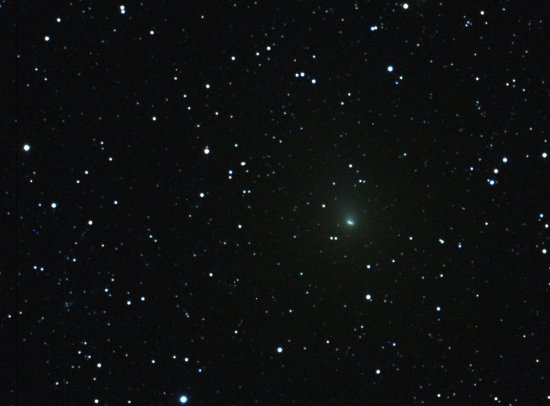Comet Passing Near Earth Offers Dim View So Far

Since the start of October, many people with smalltelescopes have followed the path of Comet Hartley 2 across the night sky. Someskywatchers are reporting an unimpressive sight so far, but the best chances tospot this comet still lie ahead.
The overall consensus suggests that seeing Comet Hartley 2 is strongly dependent onyour location, weather conditions and proximity to city lights. The comet willmake its closest approach to Earth on Oct. 20, when it will be 11.2 millionmiles (18 million km) away.
This video sky map shows where to look thismonth to see the green Comet Hartley 2, but a small telescope is advised.
From locations plagued by light pollution, actuallyseeing the comet is a difficult to near-impossible task, but even those who areblessed with dark and starry skies, finding the comet is proving a bit of achallenge. This is because the comet is large in angular size and very diffuse,spreading its light out over a large area.
Most who ultimately have located it in their telescopes or binoculars typically describeit as a nearly circular cloud, comparable in angular size to the full moon.Some photographs have shown a slight elongation of the comet's head (called thecoma) but hardly the kind of tail exhibited by other comets that attain 5th or6th magnitude.
Unimpressive green comet
Carl Hergenrother, a professional astronomerat the University of Arizona's Lunar and Planetary Lab, said his attempts toobserve the comet have yielded an unimpressive show. [Best Comet Appearances of All Time]
Breaking space news, the latest updates on rocket launches, skywatching events and more!
"At my home thecomet is a faint, barely discernible fuzzball in 10?50 binoculars. At least thecomet's location is relatively easy to find due to the large number of brightstars available for star-hopping," Hergenrother said. "Still the comet has not been an impressive sight and I'dguess that most inexperienced observers will have a hard time finding it."
Hergenrother tried to spot the comet as itpassed by the Double Cluster in the constellation Perseus, and was surprisedthat it was hard to spot.
"Because it was located near a fewbright stars, it was swamped by their glow. The proximity to the stars alsoruled out any attempt at estimating its brightness," he added. "Onone of these nights I need to drive out to a darker site and see how much of adifference that makes."
Some NASA telescopes and space observatorieshave been watching Comet Hartley 2 in advance of theanticipated rendezvous with the comet by NASA's Deep Impact spacecraft. Theprobe will zip by the comet on Nov. 4 to take a close look as part of the spaceagency's Epoxy mission.
Faint comet target'underwhelming'
To escape light pollution, Long Island, N.Y.,skywatcher Rich Tyson drove to Montauk Point to observe Comet Hartley 2 on Oct.7 using a 10-inch reflector telescope.
"The best view was at 76x(magnification), appearing as an easily seen roundish ball of light with a brightercentral condensation; the brightest part of the [coma] seemed to look slightlyelongated," Tyson said. "Upon closer examination (171x) thiselongation turned out to be a faint star seen next to the star like pseudonucleus."
Another Long Island observer was Ken Spencer,who was attending the annual Astronomy Jamboree at the Custer Institute onSouthold. He used an 8-inch telescope at 33x magnification.
"It was still very faint, and had a veryslight amount of condensation," Spencer said. "A couple of otherobservers looked at it, and we felt it was a bit underwhelming."
Veteran comet observer Charles Morris sawComet Hartley 2 just after midnight on Oct. 11 from Fillmore, Calif., with10x50 binoculars. He estimated the faint coma as 30 arc minutes across,comparable in size to the full moon. The comet was 13 million miles(nearly 21 million km) from the Earth at that time, so its true lengthcorresponds to 113,000 miles (almost 182,000 km).
Sam Storch, who this past August at theannual Stellafane Convention in Vermont received the Special Service Award fromthe Astronomical League for more than 40 years of contributions to astronomy,found Comet Hartley 2 from his son's home in Waterford, N.Y.
"On Oct. 10, the Milky Way was onlybarely visible, and I decided that I'd only have one chance to see thecomet," Storch said. "It took no more than a minute to enjoy the easyspectacle of the Double Cluster again, and with some difficulty, we got Hartley2 as a barely discernible grayish brightening of the sky at around 29x. Webagged it!"
Closest on Wednesday
Comet Hartley 2 will make its closestapproach to the Earth within the next several days. At3 p.m. Eastern daylight time on Wednesday, Oct. 20, the comet will be at itsclosest to our planet ? a distance of 11.2 million miles (18 million km).
It's quite unusual for any comet to approach this closeto Earth; it happens on average perhaps three or four times a century. If itwere a moderately sized comet, this proximity to our planet would make for aspectacular sky show. In spring of 1996, Comet Hyakutake made a similarly closeapproach and shone as bright as the brightest stars and was accompanied by aspectacular long tail that stretched halfway across the sky.
Not so, unfortunately, for Comet Hartley 2.
During the next 10 days, the comet will race rapidly southeast acrossthe constellations Auriga and Gemini. It likely will continue to appearas a faint, diffuse fuzzball that will be best viewed under dark, pristineskies.
Under such conditions, the comet might even be glimpsedwithout any optical aid.
Skywatcher P. Horaluk of Ustupky, in the Czech Republic,reported that he could he see it with his naked eye just before local midnighton Oct. 10. For most of us, however, Comet Hartley 2 will continue to be achallenging object to locate.
Another fly-in-the-ointment is the presence of theincreasingly bright gibbous moon that has been lighting up the sky during thefirst part of the night and seriously interfering with observations of thecomet.
From mid-northern latitudes on Oct. 16, moonset is at12:56 a.m. and dawn breaks at 5:37 a.m., which means the sky will be dark andmoonless for 4 hours and 41 minutes.
But on the morning of Oct. 20 ? the day when Hartley 2will be closest ? the nearly full moon will set at 4:51 a.m. with morningtwilight beginning at 5:41 a.m., leaving just a scant 50 minutes of dark skyfor comet viewing. After that, the moon will remain above the horizon untilafter morning twilight has begun.
So if you haven't tried to see the comet under a dark skyyet, you don't have much time left.
- Video Sky Map: How to Spot Comet Hartley 2
- Telescopes for Beginners
- New Comet Photos Show Icy Target for NASA Probe
Joe Rao serves as an instructor and guestlecturer at New York's Hayden Planetarium. He writes about astronomy for TheNew York Times and other publications, and he is also an on-camerameteorologist for News 12 Westchester, New York.

Joe Rao is Space.com's skywatching columnist, as well as a veteran meteorologist and eclipse chaser who also serves as an instructor and guest lecturer at New York's Hayden Planetarium. He writes about astronomy for Natural History magazine, Sky & Telescope and other publications. Joe is an 8-time Emmy-nominated meteorologist who served the Putnam Valley region of New York for over 21 years. You can find him on Twitter and YouTube tracking lunar and solar eclipses, meteor showers and more. To find out Joe's latest project, visit him on Twitter.
